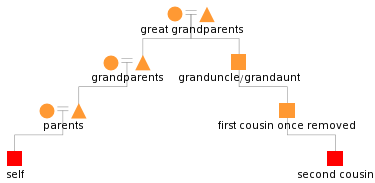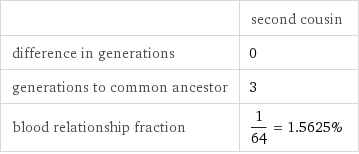Tech Tuesday: Mathematica Charting
Have you ever had a problem visualizing how a direct or collateral relation fits in to a chart? Many genealogical programs offer ways to show this with direct lines, but a rare few do so with collateral family. Even fewer take an English description and attempt to chart it out graphically.
Enter Wolfram’s Mathematica (also online as Wolfram|Alpha), a “Computational Knowledge Engine” designed for on-the-fly computations of a variety of subjects. Instead of finding the best indexed matches among already-published web pages, Mathematica and Wolfram|Alpha take the entered text and calculates a mathematical or other scientific chart. And since genealogy is a social science, there are ways to utilize this software for our needs, too.
For example, a result for something direct like “second cousin” results in two charts:

Wolfram|Alfa Second Cousin Chart

Wolfram|Alfa Second Cousin Blood Relationship
Wolfram Alpha LLC. 2011. Wolfram|Alpha. http://www.wolframalpha.com/input/?i=second+cousin (accessed 22 February 2011).
If you don’t know the standard name of a relation, it can help with that, too. One of the site’s tour examples, “father’s mother’s sister’s son,” reveals a brief chart for “first cousin once removed” (pictured as part of the above sample).
It gets harder to chart English phrases in common genealogical software in the collateral lines, even something more obvious like “cousin of cousin”, or a more separated one I mentioned back in the “The Date You Were Born” post, “second-cousin’s husband’s granduncle”:

Wolfram|Alfa Second Cousin’s Husband’s Granduncle Chart
Wolfram Alpha LLC. 2011. Wolfram|Alpha. http://www.wolframalpha.com/input/?i=second+cousin’s+husband’s+granduncle (accessed 22 February 2011).
As you can see here, larger charts might have labels that overlap, but this may be resolvable in the commercial “Mathematica” software — be sure to check their Terms for uses that require the commercial license. I don’t have that so haven’t tested at that level for this introduction.
There are some limitations or glitches in lesser-recognized patterns. Sometimes “spouse” works better than “husband” or “wife” in collateral attempts. Because only one direct path is shown as a graphical example, “10th great grandfather” shows only one possible line instead of the 2,098 possible patterns; “11th” and higher generations step down to simply “grandfather” for the computations in the free web version. Famous battles like “Battle of Hastings” show a few links to related topics like “Harold Godwinson,” “William the Conqueror,” “October 14, 1066 AD,” and others, with a brief dot in a timeline; lesser discussed battles like “Battle at Stamford Bridge” (historically just before Hastings) reveal a single odd link to the category “Soccer”.
But other interesting brief charts are available, such as:
- See charts of the prevalence of given names or surnames with the tag “name”, for instance “name John” or “name Smith”, along with some alternative spellings or nicknames that may help match other records.
- Compare name prevalence charts with commas, such as “Eric, Larry, John”.
- Show a simple timeline of historical countries the same way, such as, “Roman Empire, Frankish Empire, East Francia, Holy Roman Empire, Kingdom of Bavaria”. (An odd glitch, “Germany” doesn’t add the next step in that example’s history.)
- Compute currency through history, such as “$100 (1900 dollars)”.
So, check out Wolfram|Alpha and see if there’s a hint at something helpful in your searches of historical information. Have you found anything there that was difficult to come by in other searches? Let me know in the comments.




i like that WA calls it “grand uncle” instead of “great uncle”…genealogists prefer it that way so that the number of “greats” for your distant grandparent and his sibling are the same…on the other hand, where’s 1/64 come from for 2nd cousins?…should be 1/32…1/64 would be right for half-2nd cousins, that is, if the ancestors in the grandparents generation were only half-siblings, sharing only one parent —stolf
well OK…i went to WA and submitted “double second cousin”…it gave me what you have above, single second cousins…and 1/64, which is wrong…so much for WA… 😉 😉
Yeah, it can be stumped with easier ones, as well. “Brother” gets a 1/4 relationship instead of 1/2, and “twin brother” gets the same chart, assuming “brother” and 1/4 relationship. It seems to take the degree of relationship (siblings = 2, second cousins = 6) as the binary exponent (1/2² = 1/4) for one path, instead of calculating both common paths (common father + common mother: 1/2² + 1/2² = 2/4 = 1/2). Gets trickier when the siblings are identical (monozygotic), and they’re genetically 1/1. Thanks for the comments. 🙂